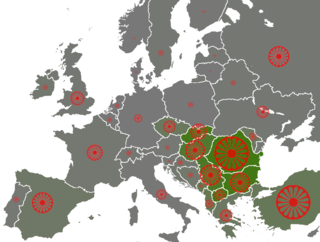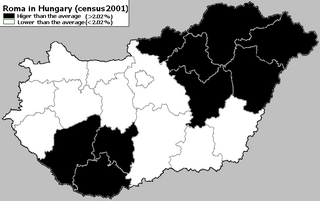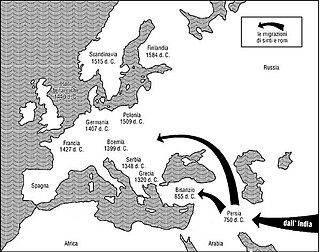Related Research Articles

The Romani, also spelled Romany or Rromani and colloquially known as the Roma, are an ethnic group of Indo-Aryan origin who traditionally lived a nomadic, itinerant lifestyle. Linguistic and genetic evidence suggests that the Romani originated in the Indian subcontinent, in particular the region of present-day Rajasthan. Their subsequent westward migration, possibly in waves, is now believed by historians to have occurred around 1000 CE. Their original name is from the Sanskrit word डोम, ḍoma and means a member of the Dom caste of travelling musicians and dancers. The Roma population moved west into the Ghaznavid Empire and later into the Byzantine Empire. The Roma are thought to have arrived in Europe around the 13th to 14th century. Although they are widely dispersed, their most concentrated populations are located in Bulgaria, Hungary, Romania, Spain, and Turkey.

The Romani Holocaust or the Romani genocide was the planned effort by Nazi Germany and its World War II allies and collaborators to commit ethnic cleansing and eventually genocide against European Roma and Sinti peoples during the Holocaust era.

David Z. Scheffel was a professor of anthropology at Thompson Rivers University in Kamloops, British Columbia, Canada.
The Romani people, also referred to as Roma, Sinti, or Kale, depending on the subgroup, are an Indo-Aryan ethnic group that primarily lives in Europe. The Romani may have migrated from what is the modern Indian state of Rajasthan, migrating to the northwest around 250 BC. Their subsequent westward migration, possibly in waves, is now believed to have occurred beginning in about 500 AD. It has also been suggested that emigration from India may have taken place in the context of the raids by Mahmud of Ghazni. As these soldiers were defeated, they were moved west with their families into the Byzantine Empire.

The Romani people are a distinct ethnic and cultural group of peoples living all across the globe, who share a family of languages and sometimes a traditional nomadic mode of life. Though their exact origins are unclear, central India is a notable point of origin. Their language shares a common origin with, and is similar to, modern-day Gujarati and Rajasthani, borrowing loan words from other languages as they migrated from India. In Europe, even though their culture has been victimized by other cultures, they have still found a way to maintain their heritage and society. Indian elements in Romani culture are almost non-existent, with the exception of their language. Romani culture focuses heavily on family. The Roma traditionally live according to relatively strict moral codes. The ethnic culture of the Romani people who live in central, eastern and southeastern European countries developed through a long, complex process of continuous active interaction with the culture of their surrounding European population.

Anti-Romani sentiment is a form of bigotry which consists of hostility, prejudice, discrimination, racism and xenophobia which is specifically directed at Romani people. Non-Romani itinerant groups in Europe such as the Yenish, Irish and Highland Travellers are frequently given the name "gypsy" and as a result, they are frequently confused with the Romani people. As a result, sentiments which were originally directed at the Romani people are also directed at other traveler groups and they are frequently referred to as "antigypsy" sentiments.

John Paskievich is a Canadian documentary photographer and filmmaker from Winnipeg, Manitoba.

Romani people are an ethnic minority in the Czech Republic, currently making up 2–3% of the population. Originally migrants from North Western India sometime between the 6th and 11th centuries, they have long had a presence in the region. Since the creation of Czechoslovakia in 1918, the Romani population have experienced considerable hardship, having been a main target of Nazi extermination programs during World War II, and the subject of forced relocation, sterilisation, and other radical social policies during the Communist era. In the successor state, the Czech Republic, challenges remain for the Romani population with respect to education and poverty, and there are frequent tensions with the white majority population over issues including crime and integration.

The Romani people have several distinct populations, the largest being the Roma and the Calé, who reached Anatolia and the Balkans in the early 12th century, from a migration out of the Indian subcontinent beginning about 1st century – 2nd century AD. They settled in the areas of present-day Turkey, Greece, Serbia, Romania, Croatia, Moldova, Bulgaria, North Macedonia, Hungary, Albania, Kosovo, Bosnia and Herzegovina, Czech Republic, Slovenia and Slovakia, by order of volume, and Spain. From the Balkans, they migrated throughout Europe and, in the nineteenth and later centuries, to the Americas. The Roma population in the United States is estimated at more than one million.
The presence of a Romani minority in Ukraine was first documented in the early 15th century. The Romani maintained their social organizations and folkways, shunning non-Romani contacts, education and values, often as a reaction to anti-Romani attitudes and persecution. They adopted the language and faith of the dominant society, being Orthodox in most of Ukraine, Catholic in Western Ukraine and Zakarpattia Oblast, and Muslim in Crimea.

Romani people in Hungary are Hungarian citizens of Romani descent. According to the 2011 census, they comprise 3.18% of the total population, which alone makes them the largest minority in the country, although various estimations have put the number of Romani people as high as 8.8% of the total population. They are sometimes referred as Hungarian Gypsies, but that is sometimes considered to be a racial slur.

According to the last census from 2021, there were 67,179 persons counted as Romani people in Slovakia, or 1.23% of the population. However, the number of Roma is usually underreported, with estimates placing the Roma population at 7-11% of the population. Thus the actual number of Roma may be over half a million.
Romani Americans are Americans who have full or partial Romani ancestry. It is estimated that there are one million Romani people in the United States. Though the Romani population in the United States has largely assimilated into American society, the largest concentrations are in Southern California, the Pacific Northwest, Southwestern United States, Texas, Louisiana, Florida and the Northeast as well as in cities such as Chicago and St. Louis.

Hungarian-Slovak Roma or Balshade immigrated to the United States in the late 19th century, many from Košice, Slovakia. They settled in the cities of Braddock, Homestead, Johnstown, and Uniontown, Pennsylvania; Cleveland and Youngstown, Ohio; Detroit and Delray, Michigan; Gary, Indiana; Chicago, and New York City and Las Vegas. The Hungarian-Slovak Roma were a community of settled Roma, and in the United States were well known for playing music for the Central European immigrant communities in which they settled. These Roma were known for playing in cafes and restaurants, the name associating these Romani as Bashaldé was made up in late 20th century, and in Hungary they are called Romungro Romani; portions of them were also known as Romungre. In the early 1900s the Roma in Braddock, Pennsylvania, purchased an entire block of homes, making them the largest population of settled Roma in the United States.
The Romani people in Canada are citizens of Canada who are of Romani descent. According to the 2021 Canadian census there were 6,545 Canadians who claimed Romani ancestry. They are sometimes referred as "gypsies", but that is considered to be a racial slur.
A Roma wall or Gypsy wall is a wall built by local authorities in the Czech Republic, Romania and Slovakia to segregate the Roma minority from the rest of the population. Such practices have been criticised by both human rights organizations and the European Union, who see it as a case of racial segregation.

David M. Crowe, Jr. is a Presidential Fellow at Chapman University and Professor Emeritus of History and Law at Elon University. He is a specialist in international criminal law, the Holocaust, the history of the Romani people in Eastern Europe and Russia, and 20th century China. He has served as an expert witness in court cases in the United States and Canada, and testified before the U.S. Congress’ Commission on Security and Cooperation in Europe and the New York City Council’s Committee on Immigration. His numerous books have been translated into six languages.

Zdena Studenková is a Slovak film and stage actress, and a musical theater singer. She is the holder of the most number of OTO Awards, having won eight times in total.

The Romani people, also known as the Roma, qualify as an ethnic minority group in Poland of Indo-Aryan origins. The Council of Europe regards the endonym "Roma" more appropriate when referencing the people, and "Romani" when referencing cultural characteristics. The term Cyganie is considered an exonym in Poland.

Romani people have been recorded in the United Kingdom since at least the early 16th century. Records of Romani people in Scotland date to the early 16th century. Romani number around est. 225,000 in the UK. This includes the sizable population of Eastern European Roma, who immigrated into the UK in the late 1990s/early 2000s, and also after EU expansion in 2004. Romani people in the UK are considered part of the Gypsy, Roma and Traveller (GRT) community. Romani people in the UK are predominantly Christian, with 71.8% of English and Welsh Romanies identifying as Christian in the 2021 census compared to 46.2% of the wider population.
References
- ↑ The Gypsies of Svinia (VHS tape, 1998). [WorldCat.org]. OCLC 74420036 . Retrieved 2012-10-12.
- ↑ Canada, Government of Canada, National Film Board of (11 October 2012). "National Film Board of Canada". www.onf-nfb.gc.ca.
{{cite web}}: CS1 maint: multiple names: authors list (link) - ↑ "Metro Cinema Society: Gypsies of Svinia". Metrocinema.org. 2002-05-17. Retrieved 2012-10-12.